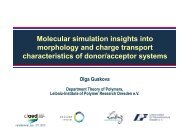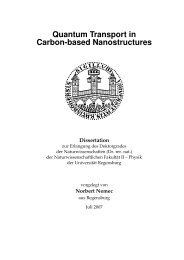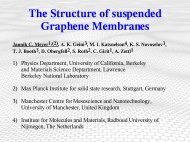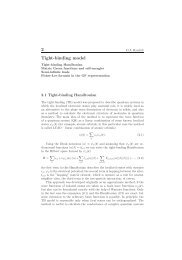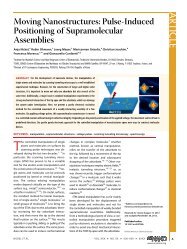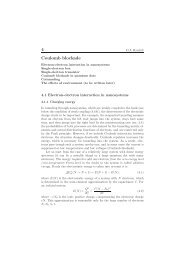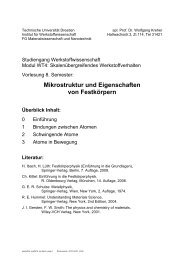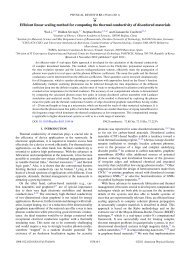Smeagol
Smeagol
Smeagol
Create successful ePaper yourself
Turn your PDF publications into a flip-book with our unique Google optimized e-Paper software.
• Developed in Trinity College Dublin in<br />
collaboration with groups from<br />
Oviedo in Spain and Lancaster in the UK<br />
• Based on the DFT code SIESTA<br />
• <strong>Smeagol</strong>: Rocha et. al., PRB 73,<br />
085414 (2006);<br />
Nature Materials 4, 335, (2005).<br />
• SIESTA: SanchezPortal et. al.,<br />
Int. J. Quant. Chem., 65, 453 (1997);<br />
Soler et. al., Jour. Phys.: Condens. Matter,<br />
14, 2745 (2002).<br />
NonEquilibrium Electronic Transport<br />
gDFTB<br />
• Developed in University of Rome<br />
Tor Vergata<br />
• Based on DFTB – DFT based tightbinding<br />
• gDFTB: A. Pecchia and A. di Carlo, Rep.<br />
Prog. Phys. 67, 1497, (2004).<br />
• DFTB: D. Porezag, Th. Frauenheim,<br />
Th. Kohler, G. Seifert, and R. Kaschner,<br />
Phys. Rev. B 51, 12947, (1995).
DFT DOS Results for PTCDA<br />
• DOS for PTCDA flat on Ag surface with periodic boundary conditions in each direction.<br />
• Tipsurface distance is 5.0 Angstrom.<br />
• Silver described by 4d5s basis set.
DFT DOS Results for PTCDA<br />
• DOS for PTCDA peeled up from Ag surface (tip – surface separation is 12 Angstrom)<br />
with periodic boundary conditions in each direction.
DFT DOS Results for PTCDA<br />
• DOS showing change in molecular orbitals (carbon pi orbitals) as molecule is peeled<br />
off silver surface.<br />
• As the molecule is peeled up, the molecular orbitals increase in energy, shifting<br />
upwards towards the Fermi level of the substrate.
Transmission Results for PTCDA from gDFTB<br />
• Transmission coefficients for PTCDA on Ag surface from gDFTB.<br />
• Resonance due to LUMO of molecule starts out 1eV below Fermi level, and then<br />
moves up due to the reverse chemisorption effect.
Transmission Results for PTCDA from <strong>Smeagol</strong><br />
• Transmission coefficients for PTCDA on Ag surface from <strong>Smeagol</strong>.<br />
• Similar to the gDFTB results, the resonance due to LUMO of molecule starts out<br />
1eV below Fermi level, and then moves up due to the reverse chemisorption effect.
Local DOS at Transmission Resonances<br />
HOMO<br />
LUMO LUMO + 1<br />
• Density of states isosurface for PTCDA flat on Ag surface in energy windows around<br />
transmission resonances.<br />
• Transmission resonances mostly correspond to pi orbitals on C and O atoms.
DOS on Oxygen atoms<br />
• HOMO and LUMO of PTCDA includes pi orbitals on carboxylic atoms but not on<br />
anhydride atoms – also apparent from local DOS on previous slide.
Comparison of gDFTB and <strong>Smeagol</strong> Results<br />
• Transmission coefficients for PTCDA flat on Ag surface comparison between gDFTB<br />
and <strong>Smeagol</strong> results.<br />
• Methods match well below Fermi level, not so well above Fermi level – may be due<br />
to problems with DFT and unoccupied states. Also, sharp peak in transmission at Fermi<br />
level does not appear to be present in the <strong>Smeagol</strong> results.
DOS of STM Tip from DFTB<br />
5 Ang separation 12 Ang separation<br />
• DOS for atoms in pyramid<br />
representing STM tip.<br />
• Spike in DOS in pyramid is<br />
present for all tip positions.<br />
• This may be responsible for spike<br />
in transmission in gDFTB results.
DOS of STM Tip from SIESTA<br />
• DOS for four silver atoms in pyramid representing STM tip.<br />
• DOS due to d orbitals is far from Fermi level.<br />
• Small peak near Fermi level due s orbital on atom at end of tip.
DOS of STM Tip<br />
• Density of states isosurface for orbitals in energy region indicated by orange lines.<br />
• Orbitals at this energy localized around tip and surface.<br />
• Also some states present on molecule in this energy region.
Conductance as a Function of Tip Position<br />
gDFTB Current<br />
<strong>Smeagol</strong> Conductance<br />
Experiment: Nanotechnology 19, 065401, (2008)<br />
• Conductance at Fermi level for PTCDA on Ag surface from <strong>Smeagol</strong>.<br />
• Large difference between experimental and computational results: in experiment,<br />
conductance increases rapidly to a maximum and then falls off. In computational<br />
results, conductance falls at first and then increases.
Conductance as a Function of Tip Position<br />
• Comparison between low bias conductance for experimental results and results<br />
from both <strong>Smeagol</strong> and gDFTB.<br />
• Order of magnitude of maximum is similar for all results, however maximum for<br />
experimental result is at minimum of theory results.
3 Layer<br />
5 Layer PBC<br />
• PRB 76, 115421, (2007)<br />
DFT DOS Results for PTCDA<br />
• DOS for carbon pz orbitals (z is direction perpendicular to surface) for PTCDA on 3<br />
and 5 layers of silver. The STM tip and periodic boundary conditions in the z direction are<br />
present for the 5 layer system.<br />
• The calculations described in PRB 76, 115421 were done with 3 silver layers, and the<br />
DOS for PTCDA on 3 layers most closely resembles the results present in that paper.
5 Layer PBC<br />
• PRB 76, 115421, (2007)<br />
DFT DOS Results for PTCDA<br />
• DOS for carbon pz orbitals (z is direction perpendicular to surface) for PTCDA on 5 layers<br />
of silver with periodic boundary conditions.<br />
• LDA calculations predict a geometrical configuration where the molecule is 0.2 to 0.3<br />
Angstroms closer to the surface than is seen in experiment.<br />
• Altering the position of the molecule by this distance has a large effect on the DOS



